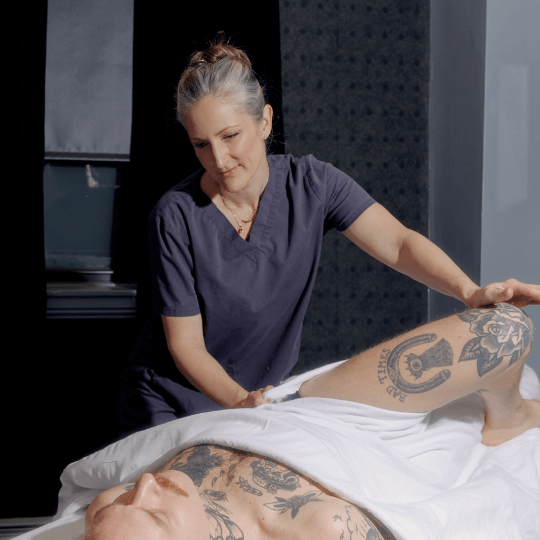Intro to treating subacute clients

This blog is devoted to something I do a lot of: working in the subacute stage of healing. If you are working with people in pain one of the worst things you can do as a therapist is be ineffective. But how do you be effective when your patient is in a stage of healing where you cannot use deep pressure or move their limbs around? It’s easy to treat low back trigger points when you can apply some pressure, but what about when you can’t?
In massage school, we were taught that working in acute was cautioned, and that you were to use techniques such as lymphatic drainage, and working compensatory muscles (which usually translates to “far away from the injury”) to treat patients. These guidelines are taught with public health in mind, and by no means am I recommending that you simply ignore them, however, after working for years I found that there are many other steps you can take. They don’t break the rules, they just require more of an understanding of how the body and nervous system work. Today we will look at the low back as an example.
Assessment: making a subacute Symptom Picture
First, get your thinking cap on. In your assessment try to separate the injury itself from the symptoms of the injury. Every injury has a symptom picture, however some of the aspects of the injury are more secondary reflexes of the body, used to protect and heal itself. Let’s look at an example:
A client comes in with low back pain, slightly left of the spine at the SI joint. Yesterday, they were lifting an object and turning at the same time, and they felt a click in the left low back and now they cannot move. You are reasonably sure, based on the symptom picture, that they have done something undesirable to the SI joint area, but of course they can’t move to do special testing. Palpating the site reveals there is heat over the joint but no noticeable swelling and the low back is pretty fixed and seems splinted, as do the glutes. Other than the pain, there are no CI’s and they called their doctor and said it was fine to have a treatment.
So where to start? As I see it, the splinting and the actual injury are two separate things. The injury is that the joint has moved unfavorably to the body and it is irritated and cranky. The side effect of this injury is that the body is neurologically saying, “Oh boy, things are really unstable, we had better build some more structure for this guy fast or things might fall apart.” Most of the pain is actually caused by the splinting pulling on the injured joint.
Treatment of the compensatory muscles
To treat this type of injury, I start by making a plan based on the injury. In this case it’s that swollen hot joint that is being pulled on by glutes, quadratus lumborum, and the psoas/iliacus. Reducing the splinting would help take the tension off the joint, lower the tone of the fascia, and allow fluid movement in the area to boost healing. But all my text books say don’t manually remove splinting by force. So now what?
First I would try and get the tone down by working compensatory muscles. Managing pain is awful; it stresses the body out and often leads to more pain. Getting your client into a relaxed state through working the cervical muscles is a great start. We can do this in prone so that you client does not have to roll over on the table. Focus on getting the shoulders to relax and the scalenes moving. This will signal to the body that its not time to ‘fight or flight’ this should help not just relax the tone, but also help reduce the pain.
Direct subacute treatment
I’d continue with the treatment by working towards the site of the pain, in this case, that is the whole lower back. As we get to the site of the splinting, I would have to switch to a much more gentle style of work. Often this is a very gentle and slow, feather-light gliding touch over the skin or a light, skin-deep Swedish massage.
While you gently massage, you should be assessing the tone. While working this area, you might notice that although your client is breathing (I hope) the low back and glutes are not moving much. When you watch your client breathe, the chest goes up, but the air stops in the thoracic spine. This is due to the splinting, and while we, as the therapist, should not attempt to remove this manually, the patient can remove it on their own, thereby lowering their own tone, activating the normal muscle pumping and relieving some of their pain.
I want to stress that during this process, your job is not to apply pressure in any way, your hand contact is only enough to palpate the muscle, to cue the client as to where the air should move, and assess the tone. Placing our fingertips on the lateral edge of the quadratus lumborum (make sure its the side of the muscle not downward) palpate just deep enough to feel the muscle, your client should feel no pain at your touch. Then ask your client to take a long slow breath. If the air does not move down to where the lower back expands, cue them by saying, “I want you to breath into where my hand is.”
As they breathe in and out, slowly expanding the area, you will likely notice that the tone in the low back falls, as does the pain level. This process could take up to five minutes on each quadratus lumborum. This same technique can also be used along the iliac crest (or any area where the client can move air, such as the cervical spine) following the line of the top of the glutes as the pelvic floor and iliac spine are also affected by breathing. If at any time your client responds with pain, immediately discontinue. For some cases, I also put a pillow under the stomach to limit the amount of belly expansion and increase back expansion. Never push the client past where they want to go; at all times they should be in control of this activity.
Analysis and conclusion
 What is happening when we do this? A few possibilities exist, actually!
What is happening when we do this? A few possibilities exist, actually!
- In one sense, it’s possible we’re not technically doing anything, but the client’s slow, steady breathing stimulates their parasympathetic system, reducing symptoms by proxy.
- Secondarily, sometimes pain might be signaled due to immobility. By producing the stimulation of movement, the brain could register that the injury is healing and not loosen the tightness around it, giving relief to the client.
- Lastly, your lymph system and some of your circulatory system is driven by muscle pumping. When you approximate the air flowing into an area, you are also working the fluids like pumping a bellows, which is how the body heals.
I find it extremely helpful to be upfront with subacute clients by managing their expectations. During the intake and consent I will almost always say something along the lines of “it sounds like _____ is happening, but I am not a doctor. We have to treat conservatively until you find out exactly what is going on. We can probably get you more comfortable while you wait however.”
Usually, if it was nothing that serious, you have helped them a great deal, and the next time you see them, it will be to finish up the work that is headed for chronic. If that pain persists, you are confused by a symptom picture or feel unsure in any way, you always refer them out. But by taking these somewhat radical steps and thinking outside the box, we have least armed ourselves with an option to treat the client to ease their pain.
- May 2025
- April 2025
- March 2025
- February 2025
- January 2025
- December 2024
- November 2024
- October 2024
- September 2024
- August 2024
- July 2024
- June 2024
- April 2024
- March 2024
- February 2024
- January 2024
- November 2023
- October 2023
- September 2023
- July 2023
- April 2023
- March 2023
- January 2023
- October 2022
- June 2022
- May 2022
- March 2022
- February 2022
- January 2022
- December 2021
- November 2021
- October 2021
- September 2021
- August 2021
- July 2021
- June 2021
- May 2021
- April 2021
- March 2021
- February 2021
- January 2021
- December 2020
- November 2020
- October 2020
- September 2020
- August 2020
- June 2020
- March 2020
- February 2020
- January 2020
- November 2019
- October 2019
- September 2019
- August 2019
- June 2019
- May 2019
- April 2019
- March 2019
- October 2018
- September 2018
- June 2016
- April 2016
- February 2016
- January 2016
- September 2015
- August 2015
- July 2015
- May 2015
- April 2015
- March 2015
- January 2015
- August 2014
- July 2014
- June 2014
- April 2014
- March 2014
- February 2014
- January 2014
- December 2013
- November 2013
- September 2013
- August 2013
- anxiety (1)
- Back Pain (11)
- Body Mechanics (24)
- Body Mechanics Blog (15)
- Bursitis (1)
- business (6)
- Carpal Tunnel (1)
- ceu's (1)
- Continuing Education Credit (1)
- COVID (1)
- Cupping (1)
- deep tissue (4)
- dyi (1)
- Foot Pain (1)
- General (45)
- healthcare (47)
- insurance (2)
- lymphatic massage (2)
- Massage Education (1)
- massage NYC (38)
- massage therapy (47)
- NYC Marathon (4)
- Orthopedic Massage (36)
- pain management (12)
- pain managment (3)
- pain science (7)
- Plantar Fasciitis (1)
- Plantars Fascitis (1)
- Prenatal Massage (11)
- preventative care (14)
- relaxation (4)
- rub (1)
- Runners Massage (4)
- running (4)
- sleep (2)
- Sports Massage (23)
- stress (2)
- Stretches (11)
- subacute (1)
- swedish massage (2)
- tendons (1)
- Therapist Profile (6)
- TMJ Massage (4)
- Training (1)
- treatment techniques (1)
- Uncategorized (35)
- World Health Day (1)

